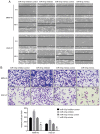MicroRNA-9 inhibits gastric cancer cell proliferation and migration by targeting neuropilin-1
- PMID: 31572503
- PMCID: PMC6755461
- DOI: 10.3892/etm.2019.7841
MicroRNA-9 inhibits gastric cancer cell proliferation and migration by targeting neuropilin-1
Retraction in
-
[Retracted] MicroRNA‑9 inhibits gastric cancer cell proliferation and migration by targeting neuropilin‑1.Exp Ther Med. 2024 Aug 12;28(4):398. doi: 10.3892/etm.2024.12687. eCollection 2024 Oct. Exp Ther Med. 2024. PMID: 39171144 Free PMC article.
Abstract
Gastric cancer (GC) is a global health problem with poor clinical outcomes. The mechanism of its development and progression remains largely unclear. The present study investigated the role of microRNA-9 (miR-9-5p) in the development and progression of GC. Overexpression of miR-9-5p led to reduced expression of neuropilin-1 (NRP-1) in GC cells. Dual-luciferase reporter assay results indicated that miR-9-5p directly targeted NRP-1. Furthermore, overexpression of miR-9-5p in GC cells increased the expression of mesenchymal markers, N-cadherin and vimentin, and decreased the expression of epithelial markers, E-cadherin and β-catenin. Overexpression of miR-9-5p inhibited GC cell proliferation, migration and invasion, and increased the sensitivity of GC cells to the anti-cancer drug cisplatin. By contrast, the opposite effects were observed in GC cells following downregulation of miR-9-5p. Taken together, the present findings suggested that miR-9-5p suppressed NRP-1 expression and inhibited GC cell proliferation and invasion. In addition, miR-9-5p overexpression attenuated GC cell resistance to anti-cancer drugs, which highlighted the potential of miR-9-5p as a target for the treatment of GC.
Keywords: gastric cancer; microRNA-9; neuropilin-1.
Copyright: © Hang et al.
Figures




Similar articles
-
MicroRNA-34c-5p exhibits anticancer properties in gastric cancer by targeting MAP2K1 to inhibit cell proliferation, migration, and invasion.Biomed Res Int. 2022 Sep 27;2022:7375661. doi: 10.1155/2022/7375661. eCollection 2022. Biomed Res Int. 2022. PMID: 36203485 Free PMC article.
-
Knockdown of Circ_0081143 Mitigates Hypoxia-Induced Migration, Invasion, and EMT in Gastric Cancer Cells Through the miR-497-5p/EGFR Axis.Cancer Biother Radiopharm. 2021 May;36(4):333-346. doi: 10.1089/cbr.2019.3512. Epub 2020 Jul 15. Cancer Biother Radiopharm. 2021. PMID: 32678674
-
Upregulation of microRNA-524-5p enhances the cisplatin sensitivity of gastric cancer cells by modulating proliferation and metastasis via targeting SOX9.Oncotarget. 2017 Jan 3;8(1):574-582. doi: 10.18632/oncotarget.13479. Oncotarget. 2017. PMID: 27880941 Free PMC article.
-
MicroRNA-140-5p suppresses cell proliferation and invasion in gastric cancer by targeting WNT1 in the WNT/β-catenin signaling pathway.Oncol Lett. 2018 Nov;16(5):6369-6376. doi: 10.3892/ol.2018.9480. Epub 2018 Sep 21. Oncol Lett. 2018. PMID: 30405773 Free PMC article.
-
sMicroRNA-28-5p acts as a metastasis suppressor in gastric cancer by targeting Nrf2.Exp Cell Res. 2021 May 15;402(2):112553. doi: 10.1016/j.yexcr.2021.112553. Epub 2021 Mar 15. Exp Cell Res. 2021. PMID: 33737068
Cited by
-
miR-9-5p Promotes Lung Adenocarcinoma Cell Proliferation, Migration and Invasion by Targeting ID4.Technol Cancer Res Treat. 2021 Jan-Dec;20:15330338211048592. doi: 10.1177/15330338211048592. Technol Cancer Res Treat. 2021. PMID: 34723712 Free PMC article.
-
N7-methylguanosine-related miRNAs predict hepatocellular carcinoma prognosis and immune therapy.Aging (Albany NY). 2023 Nov 3;15(21):12192-12208. doi: 10.18632/aging.205172. Epub 2023 Nov 3. Aging (Albany NY). 2023. PMID: 37925170 Free PMC article.
-
miR-9 utilizes precursor pathways in adaptation to alcohol in mouse striatal neurons.Adv Drug Alcohol Res. 2023;3:11323. doi: 10.3389/adar.2023.11323. Epub 2023 Jun 6. Adv Drug Alcohol Res. 2023. PMID: 38116240 Free PMC article.
-
Knockdown of lncRNA ZNRD1-AS1 suppresses gastric cancer cell proliferation and metastasis by targeting the miR-9-5p/HSP90AA1 axis.Aging (Albany NY). 2021 Jul 2;13(13):17285-17301. doi: 10.18632/aging.203209. Epub 2021 Jul 2. Aging (Albany NY). 2021. PMID: 34226297 Free PMC article.
-
Evaluation of Serum MicroRNAs (miR-9-5p, miR-17-5p, and miR-148a-3p) as Potential Biomarkers of Breast Cancer.Biomed Res Int. 2022 Jan 24;2022:9961412. doi: 10.1155/2022/9961412. eCollection 2022. Biomed Res Int. 2022. PMID: 35111850 Free PMC article.
References
Publication types
LinkOut - more resources
Full Text Sources
Research Materials
Miscellaneous
